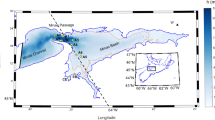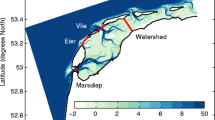Abstract
The development and application of a Lagrangian particle-tracking model to simulate sediment transport in the Mersey Estuary (UK) is described. Each of the particles (up to a million in total) is advected horizontally by the 3-D tidal currents. Related vertical movements are: (1) downwards by settlement at a prescribed velocity w s and (2) both upwards and downwards by a distance related to the vertical eddy diffusivity. In a novel departure from traditional practice, where initial distributions of surficial sediments are specified, all particles are introduced at the seaward boundary of the model. Provenance studies indicate surficial sediments are overwhelmingly of marine origin. For the predominant fine sediments, ‘cyclical convergence’ in suspended sediment concentrations is approximated after about two spring-neap tidal cycles. Comparisons are shown between the suspended sediment concentrations and net deposition rates computed by this model against observed values and earlier computations utilising both 1-D and 3-D Eulerian models. While all of these results are in broad agreement, the flexibility of the Lagrangian approach for simulating flocculation, consolidation and mixed sediments illustrates its future potential.








Similar content being viewed by others
References
Fischer HB, List EJ, Koh RCY, Imberger J, Brooks NH (1979) Mixing in inland and coastal waters. Academic, New York, p 483
Hill DC, Jones SE, Prandle D (2003) Dervivation of sediment resuspension rates from acoustic backscatter time-series in tidal waters. Cont Shelf Res 23(1):19–40
Lane A (2004) Bathymetric evolution of the Mersey Estuary, UK, 1906–1997: causes and effects. Estuar Coast Shelf Sci 59(2):249–263
Lane A, Prandle D, Harrison AJ, Jones PD, Jarvis CJ (1997) Measuring fluxes in estuaries: sensitivity to instrumentation and associated data analyses. Estuar Coast Shelf Sci 45(4):433–451
Manning AJ, Dyer KR (2002) A comparison of floc properties observed during neap and spring tidal conditions, pp 233–250. In: Winterwerp JC, Kranenburg C (eds) Fine sediment dynamics in the marine environment. Proceedings in marine science, 5, Elsevier, Amsterdam, p 713
Prandle D (1982) The vertical structure of tidal currents and other oscillatory flows. Cont Shelf Res 1:191–207
Prandle D (1997) Tidal characteristics of suspended sediment concentrations. ASCE, J Hydraul Eng 123(4):341–350
Prandle D, Murray A, Johnson R (1990) Analyses of flux measurements in the River Mersey. pp 413–430. In: Cheng RT (ed) Residual currents and long term transport, coastal and estuarine studies, 38, Springer, Berlin Heidelberg New York, 544 pp
Thomas CG, Spearman JR, Turnbull MJ (2002) Historical morphological change in the Mersey Estuary. Cont Shelf Res 22(11–13):1775–1794
Author information
Authors and Affiliations
Corresponding author
Additional information
Responsible Editor: Paulo Salles
Rights and permissions
About this article
Cite this article
Lane, A. Development of a Lagrangian sediment model to reproduce the bathymetric evolution of the Mersey Estuary. Ocean Dynamics 55, 541–548 (2005). https://doi.org/10.1007/s10236-005-0011-8
Received:
Accepted:
Published:
Issue Date:
DOI: https://doi.org/10.1007/s10236-005-0011-8




